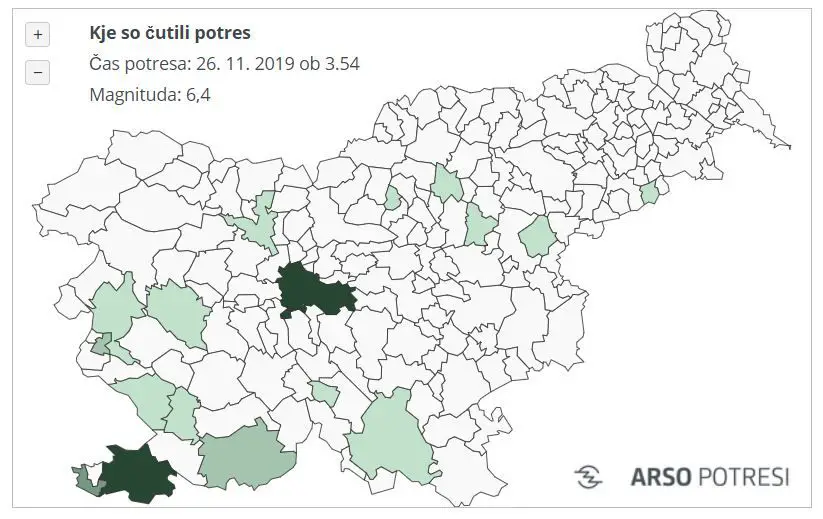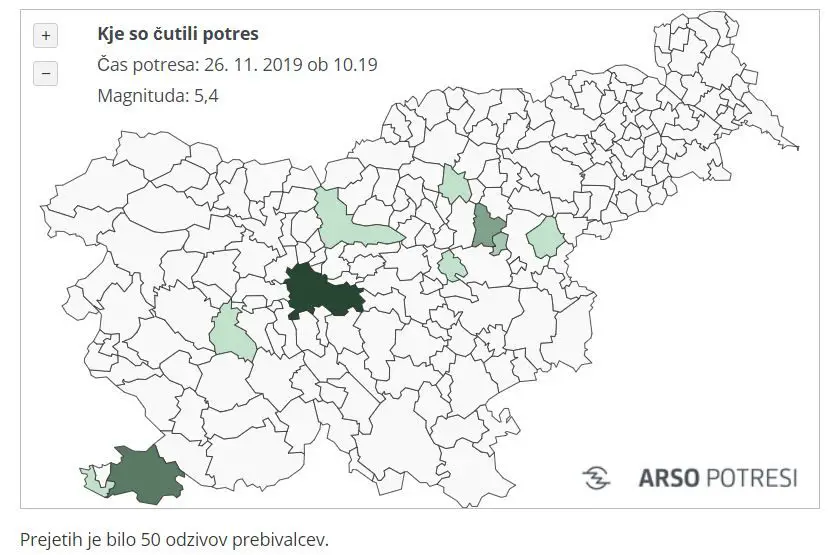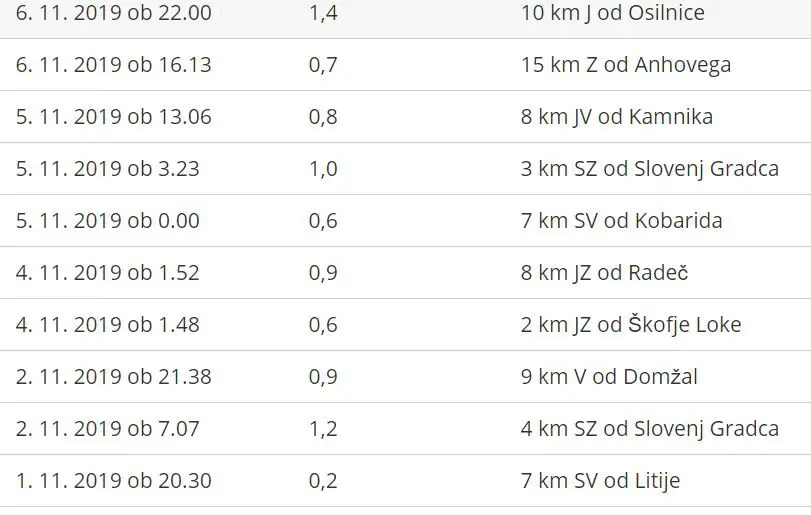Ljubljana related
STA, 4 October 2021 - The national earthquake response drill #SIQUAKE2020 got under way on Monday in the Ljubljana area. The goal is to check the country's preparedness to a major earthquake in central Slovenia. Until Friday about 500 rescuers will take part in the drill at 12 locations.
Rescuers, members of the civil protection and disaster relief, its regional units, bodies and services, NGOs active in civil protection and disaster relief specialising in earthquakes as well as specialised units from Italy, Austria, Croatia and Hungary will take part in the drill in Ljubljana, Logatec, Vrhnika and Ig, with activities planned during the day and during the night.
In line with the earthquake scenario, other countries would respond to Slovenia's request for international aid.
As part of the drill, participants will assess the damage on buildings, set priorities, practice search and rescue skills, and stabilise damaged buildings.
They will provide emergency aid and set up temporary shelters for the people. About 150 people will participate as the injured, simulating mild and severe injuries.
According to the head of the firefighters' training programme, Aleš Cedilnik, the purpose of the drill is to check the solutions from the national plan, the civil protection and disaster relief plan for earthquake, and the readiness for action in case of an earthquake at the national, regional and municipal levels, and at the level of institutions and NGOs.
On Thursday, European Crisis Management Commissioner Janez Lenarčič will be on a working visit to Slovenia to take part in the drill.
The Administration for Civil Protection and Disaster Relief organised the drill in consortium with partners from the Ljubljana city municipality, Germany, Croatia and Italy and the support of the EU mechanism for civil protection in 2019-2021.
The SIQUAKE2020 project has been under way since 2019 with the support of the EU's mechanism for civil protection. It includes various activities and events such as drills, workshops and training for different types of rescuing at different levels.
STA, 3 March 2021 - The national Seismology Office has presented a new seismic hazard map for Slovenia, taking into account the latest seismic and geo-tectonic data. The upgraded danger levels and risk assessment are based on the new findings of the past two decades.
The old seismic hazard map dates back to 2001 and the new one will step into force when the changes to the earthquake resistant construction legislation are passed.
Based on the new earthquake risk assessment, engineers will establish whether national building codes in line with the Eurocode 8 seismic hazard zoning standards need to be changed.
The new map shows peak ground acceleration as well as spectral acceleration to include all possible building frequencies.
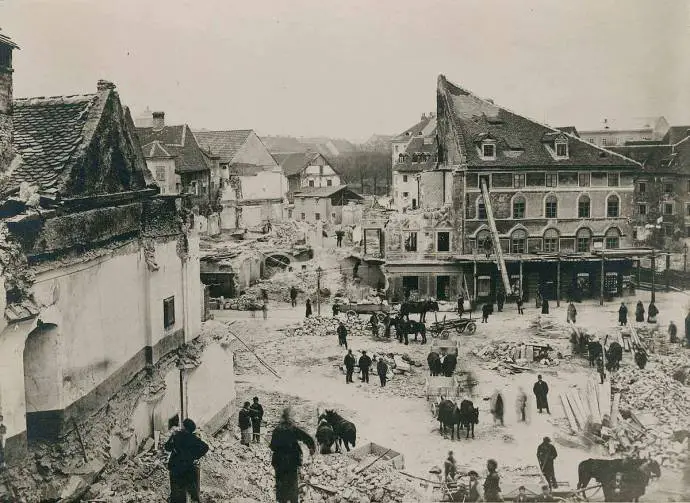
Related: Old Photos - Ljubljana After the 1895 Earthquake
Seismic hazard levels are assessed for firm ground sites using earthquake sources probability assessment and taking into account the expected lifespan of average buildings.
The upgraded version was drawn up based on the latest data used for the new European seismic hazard map and specific regional circumstances. The list of earthquakes in the country and its vicinity has been brought up to date as well.
Active faults or ground breaks and their sources, defined by the Geological Survey of Slovenia, have been included in the map for the first time ever, meaning risk levels are now assessed not just on the basis of previous quakes but also on potential fault hotspots.
Areas with the highest earthquake hazard in Slovenia are the Posavje region in the east, the Novo Mesto area in the south-east, the capital Ljubljana and certain areas in the north-west and west of the country, particularly the Kobarid, Bovec and Idrija areas. On the other hand, the coast, the Maribor area and the north-east are safest.
If you’d like to keep up-to-date with the latest in seismic activity as it relates to Slovenia, there’s the government website (in Slovene) here, while an international site, in English and searchable by location, is here.
STA, 29 December 2020 - Prime Minister Janez Janša spoke with his Croatian counterpart Andrej Plenković on Tuesday to offer Slovenia's assistance in the relief efforts following a devastating earthquake near Petrinja, south-east of the capital of Zagreb. Solidarity and readiness to help was also expressed by President Borut Pahor.
Janša added in his post on Twitter that the Slovenian Civil Protection and Disaster Relief Administration was in the state of alert and was in direct contact with the authorities in Croatia.
President Borut Pahor also announced on Twitter that he had just spoken with Croatian President Zoran Milanović, who is on his way to the affected area. Pahor expressed compassion, solidarity and readiness of Slovenia to help the neighbouring country.
The 6.4-magnitude earthquake hit around midday. The epicentre of the earthquake, which was felt in large swathes of Slovenia, was 46 kilometres south of Zagreb near Petrinja, the epicentre of a 5.2-magnitude earthquake on Monday.
Janša said in a subsequent tweet that, according to the information collected so far, no significant damage had been recorded in Slovenia apart from several damaged facades, church towers and chimneys.
The prime minister also announced on the occasion that a national earthquake response exercise would be organised in 2021.
The Krško Nuclear Power Station, jointly owned by Slovenia and Croatia and located roughly 80 kilometres north-west of Petrinja, was shut down today as a precaution in what is standard procedure in the event of a strong earthquake.
The earthquake was felt in the building of the Slovenian National Assembly as the MPs were holding a session, which was suspended for more than half an hour by Speaker Igor Zorčič.
Some of the MPs left the building, and after they returned, Zorčič told the press that he had certainly felt the tremor, although "I have to admit that for us politicians, the ground is always shaking beneath our feet."
Matjaž Han, the head of the deputy group of the opposition Social Democrats (SD), expressed support for Croatians who are facing such a tragedy amidst holidays. "If we can help them in any way, we should make ourselves available," he added.
STA, 22 March - The Krško Nuclear Power Station (NEK) said on Sunday that a preventive examination of systems and equipment had not detected any damage or impact on operations caused by a severe earthquake in Zagreb that was felt in Slovenia as well. However, Austrian politicians reiterated their calls for the closure of Slovenia's sole nuclear power plant.
The power station, situated roughly 50 kilometres north-west of Zagreb and hence close to the earthquake's epicentre, is operating normally, said the Nuclear Security Administration, adding that no safety alarm had gone off either.
NEK spokeswoman Ida Novak Jerele told the STA that the nuclear plant had various and specific protocols prepared in case of potential natural or other disasters. Nuclear experts performed their tasks and analyses in line with them today as well, she added.
Meanwhile, the Austrian press agency APA reported that cross-partisan calls for the NEK shutdown followed the 5.3 magnitude quake. A number of Austrian politicians said that the plant posed a great risk to the region's security and that its lifespan was coming to an end.
"It all turned out well this time, but what about next time," the governor of the Austrian state of Carinthia, Peter Kaiser, told the media. He said that a transition to alternative energy resources did not have an alternative in the medium-term and long-term.
The Austrian politicians highlighted that NEK had a limited lifespan and would have to be closed by 2023, saying that today's earthquake should be a wake-up call reminding Slovenia to shut down its sole nuclear power plant.
They all agreed that plans to build a new reactor at the power station would have to be dropped. The last time Austria protested over this issue was last year in August when the then Prime Minister Marjan Šarec said that all the efforts had to go into the construction of another reactor.
Slovenia sending quake aid to Croatia
STA, 22 March 2020 - Slovenia has dispatched emergency relief aid to Croatia in response to the neighbouring country's appeal for help via the European civil protection mechanism after a magnitude 5.3 earthquake hit the capital Zagreb on Sunday morning.
In line with a decision taken by the government earlier in the day, Slovenia dispatched ten tents equipped to accommodate up to 80 people with 60 beds and 60 sleeping bags and 20 heating devices.
The lorry carrying EUR 107,000 worth of material aid was sent off from the civil protection facility on the northern outskirts of Ljubljana by Defence Minister Matej Tonin, who called for continued solidarity in Europe in the face of the coronavirus outbreak and natural disasters such as the latest quake.
"That's the least we can do to help our neighbours in these moments of crisis," he said. "If ever, Europe needs solidarity today and this aid is Slovenia's expression of that solidarity."
Prime Minister Janez Janša offered Croatia help in a phone call with his counterpart Andrej Plenković in the morning, as did Foreign Minister Anže Logar in a phone call with his counterpart Gordan Grlić Radman.
Solidarity with Croatia has also been expressed by President Borut Pahor in a longer telephone call with his Croatian opposite number Zoran Milanović.
The quake, which was also felt by people throughout Slovenia, left at least 15 people with injuries, including a gravelly injured 15-year-old girl. It also caused considerable damage to buildings and cars.
Janša tweeted that the quake did not cause any significant damage in Slovenia and the Krško Nuclear Power Station on the border with Croatia has not been affected.
STA, 22 March 2020 - A strong earthquake with its epicentre just north of Zagreb, the capital of Croatia, was felt across Slovenia Sunday morning. The 5.3 magnitude quake struck at 6.24am at a depth of 10 kilometres and was followed by two strong aftershocks, according to the European Mediterranean Seismological Centre (EMSC).
The tremors were picked up by sensors all across Slovenia, according to the Environment Agency, with people all over the country reporting having felt the quake to varying degrees.
Social media photos and videos from Zagreb suggest extensive damage to buildings, including hospitals.
At least one death was initially reported, however the Zagreb children's hospital head Goran Roić later said that efforts were underway to resuscitate a 15-year-old that had been reported to have been killed in the earthquake.
The teenager is in a highly critical condition, he highlighted. Other people have reportedly suffered injuries as well.
Meanwhile, in Slovenia there have been no reports so far about damage in localities closest to the epicentre.
In the border town of Brežice the tremors were strong but Mayor Ivan Molan does not expect damage beyond fallen roof shingles. In nearby Krško there had been no reports of damages either, Mayor Miran Stanko told the STA.
Krško is home to Slovenia's sole nuclear power plant, which is roughly 50 kilometres north-west of Zagreb and hence close to the epicentre.
After conducting a preventive examination of systems and equipment, the power station reported that the earthquake had not caused any damage or any other impact on operations. The power plant is operating normally, said the Nuclear Security Administration, adding that no alarms had gone off during the earthquake.
The Infrastructure Ministry said earlier on Twitter nuclear energy experts were conducting analyses in line with protocols and there was no reason whatsoever for a shutdown.
Following the earthquake, Prime Minister Janez Janša talked to his Croatian counterpart Andrej Plenković and offered Slovenia's assistance to Croatia. He was joined by Foreign Minister Anže Logar.
President Borut Pahor also expressed his solidarity with Croatia during a phone call with his Croatian counterpart Zoran Milanović.
Due to the technical problems related to the quake on the Croatian side, border crossings Rigonce, Obrežje and Slovenska Vas have been closed.
More details on this earthquake can be found here, while if you want to see all the (usually very minor) earthquakes that are felt in Slovenia then you can do that here
In a recent survey conducted by the Institute of Civil Engineering, the Architecture Studio Krištof and the Faculty of Arts at the University of Ljubljana, the experts examined possible solutions for earthquake reinforcement of the 15 most obviously problematic apartment blocks in the centre of Ljubljana that were built between the years 1959 and 1965, and for five of them they see no other solution than demolition and replacement construction.
The survey was commissioned by the Ljubljana City Government, with a focus on 15 buildings built before the first rules on earthquake-resistant construction were introduced following the 1963 earthquake in Skopje. In addition to the building standards, the criterion was also the height of the buildings, since the densest settlement would put most people at risk in the event of a collapse. The buildings in question are all towers between nine and 12 floor high, with only a few of them having even the minimum amount of reinforcement.
According to Marjana Lutman of the Institute of Civil Engineering, for ten of the buildings adequate earthquake safety can be achieved by internal or external fortification. For towers on Štefanova, Rozmanova, Pražakova and Cigaletova Street as well as Hrvatski trg, however, the experts see no other solution but demolition.
Amid mounting real estate prices in Ljubljana centre the question arises what exactly does this mean for the owners of apartments in these buildings?
For the national broadcaster’s MMC portal the city government explained that the results of the survey only indicate possible solutions, and that concern for the earthquake safety of buildings is primarily the responsibility of the owners. It is up to them to decide whether or not to accept the proposals.
However, interventions to increase seismic safety are associated with high costs. Both exterior and interior fortifications are expected to cost an average of € 5 million for each building, or more than € 110,000 for each housing unit. In contrast, the complete replacement of an old building with a new one would cost an average of almost € 8 million, which means up to € 180,000 per household.
Some apartment owners are convinced that the earthquake safety standards in the survey were unrealistic and that human factors could be taken into account in such cases, and so the criteria could be slightly adjusted. “Standard Eurocode 8 assumes 100% safety, but it does not hold that 100% safety must be maintained in order for a building to survive or fail in a major earthquake. We probably won’t just demolish the old city centre of Ljubljana just because it doesn’t meet the Eurocode 8 standard,”' stated an architect and resident of one of the endangered towers for MMC, Nika Grabar.
“Slovenia is located in a very earthquake-prone area, and according to some estimates there are more than 2000 earthquake safety inadequate buildings in Ljubljana and around 550 in Maribor, among them several schools and other public institutions,” stated Dr. Peter Fajfar of the Faculty of Civil Engineering and Geodesy for MMC. “There are 39 schools in Slovenia that were built at the most critical time, 14 of which are in Ljubljana. While considerable obstacles can be found with tackling this problem when it comes to private property in residential buildings, the state has no reason not to immediately undertake earthquake reinforcement measures when it comes to its own buildings,” he added.
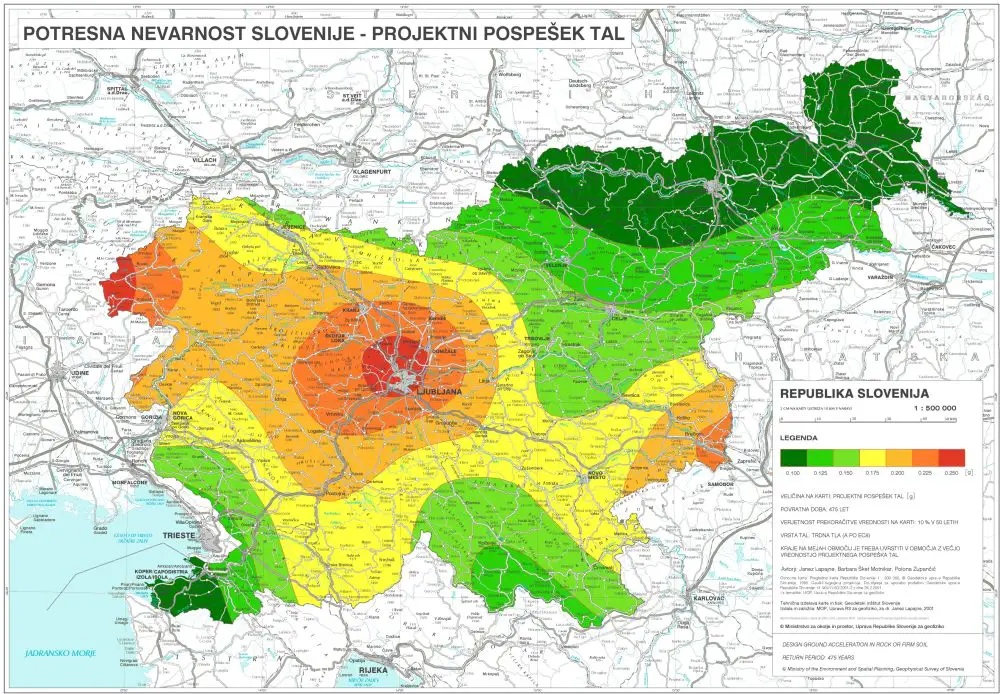
All our stories about earthquakes and Slovenia can be found here
Did you feel Wednesday morning’s earthquakes in Albania (03:54) and Bosnia & Hercegovina (10:19)? The Slovenian Environment Agency (Agencija RS za okolje) received 50 and 58 reports (at the time of writing), respectively, with the tremors being felt in, among other places, Ljubljana and Primorska.
The density of reports for the quake in Albania…
…and for that in Bosnia & Hercegovina.
You might be surprised at the amount of seismic activity Slovenia experiences on a near daily basis, and often several times a day. There were 36 earthquakes recorded between 28 October and 16 November alone, none stronger than 1.9, and most of these went unreported. The strongest had a magnitude of 1.9 and happened 09:00 18 November (2019) 5km from Črna na Koroškem (see more here).
Find our where and when the earth moved.
If you feel something, then visit the website and click on the earthquake, look for Čutil sem ta potres (I felt this earthquake) and answer the questionnaire. It’s only in Slovene, but works well with Google Translate.
STA, 5 April 2019 - Physicist Jure Žalohar has combined a number of seismic studies to come up with a new way to potentially predict earthquakes in the future. His theory suggests earthquakes are not coincidental but are caused by synchronised processes in the Earth's crust.
Žalohar's theory was introduced in his book The Omega-Theory: A New Physics of Earthquakes, which was released in May 2018.
It is based on a number of studies conducted by seismology, geophysics, and maths experts in the past two decades and could prove effective if put into practice through an IT system.
Seismology or the study of earthquakes tried to forecast earthquakes in the 20th century by taking into account various precursors, such as animal behaviour, regional transformations of topography, changes in the speed of primary and secondary seismic waves, or radon gas emissions.
These efforts were only partially successful, with many studies focusing on possible causes for earthquakes, but none of them coming up with the exact way of predicting them.
In 1997, journal Science published an article saying that earthquakes could not be forecast. The bold claim did not discourage scientists from continuing their research.
They succeeded in developing two theories; the theory of the Earth's tectonic plate movement and the theory of the epicentre mechanism. The majority of earthquakes occur at or near the boundaries between tectonic plates.
Žalohar's Omega theory, which could be described as a rotation theory of earthquakes, is based on the already established phenomenon of the plates' splits tending to be parallel and intersecting.
According to Žalohar, the plates are "enormous omega cells", experiencing earthquake sequences stemming from parallel splits, with the famous golden ratio determining the number of those splits. Earthquakes are thus connected between themselves and affected by the Earth's rotation.
The Omega theory suggests that earth tremors are not coincidental but a result of "highly synchronised processes" in the Earth's crust, which indicates they could be predicted.
The software programme T-Tecto was created on the basis of the theory, currently providing only one model of earthquake forecasting which includes a 64-day prediction.
An IT centre that could build on that and further develop the method would require additional funding and special training for monitoring personnel, said Žalohar.
The ability to forecast earthquakes would also entail potential ethical issues in case it was not confined to authorised organisations.
All our stories about earthwuakes and Slovenia can be found here
STA, 6 December 2018 - The government has adopted a disaster risk assessment report for the past four years and a new national disaster risk assessment which finds that floods are the only top-level risk to the country.
The report sets out scenarios for various types of accidents or disasters and their effects on the population, business, the environment and cultural heritage. It also assesses probability levels.
Considering the scope of political and social impacts and the likelihood of disaster, the only top-level risk to the country is represented by floods.
An earthquake, ice storm or the risks of biological, chemical, environmental or of unknown nature for people's health are assessed as entailing high-level risk.
Related: Floods in Slovenia, Especially Along Drava (Videos)
Meanwhile, a nuclear accident is assessed as mid-level risk because of the very small likelihood of such an accident happening.
Also assessed as middle-level risks are cyber threats and large wildfires, despite being assessed as the likeliest of all types of accident.
The lowest level of risk represent radiological or train accidents.
Related: Slovenia’s 38th Earthquake of the Years Strikes Near Postojna
The biggest impact from the aspect of the effect on people is attributed to a major nuclear incident at the Krško Nuclear Power Plant.
In the worst-case scenario and providing inadequate protection measures, up to one thousand people could die and up to several thousand could be injured or exposed to radioactivity. Between 40,000 and 100,000 would have to be moved from the area permanently.
The country would also face grave consequences in case of a flu pandemic, which falls in the category of a danger of risks of biological, chemical, environmental or unknown nature on people's health.
Such a pandemic could claim some 1,850 lives with up to 45% of the country's population taken ill, although not within days but in a space of between several months and up to almost a year.
A major earthquake in central Slovenia would claim 60 casualties, 600 injured and the evacuation of more than 5,000 people.
The map at the top of this story is from the Institute of Water for the Republic of Slovenia
Slovenia has experienced 38 earthquakes so far in 2018, with most below 3 on the Richter (ML) scale, that figure being exceeded only twice.
First on January 17th, when a 3.8 quake hit the north west of the county, not far from Čezsoča, at a depth of 5 km. Second today, December 5, when at 17:23 a 3.4 magnitude quake struck just outside of Knežak, near Postojna, at a depth of 14 km, and felt at least 44 km away, in Ljubljana.
Related: Old Photos - Ljubljana After the 1895 Earthquake
By coincidence, Dnvenik reported today that a study has concluded more than 41,000 homes in Ljubljana, with around 86,000 residents, were developed before the 1963 Skopje earthquake (6.1 ML) that led to the introduction of tougher standards, and thus could be at risk of significant damage if a similar quake occurred.
If you’d like to keep up-to-date with the latest in seismic activity as it relates to Slovenia, there’s the government website (in Slovene) here, while an international site, in English and searchable by location, is here.


